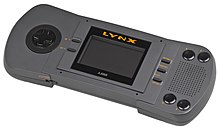
The Atari Lynx is a 16-bit fourth-generation hand-held game console released by Atari Corporation in September 1989 in North America and 1990 in Europe and Japan. It was the first handheld game console with a color liquid-crystal display. Powered by a 4 MHz 65C02 8-bit CPU and a custom 16-bit blitter, the Lynx was more advanced than Nintendo's monochrome Game Boy, released two months earlier. It also competed with Sega's Game Gear and NEC's TurboExpress, released the following year.
The fifth generation era refers to computer and video games, video game consoles, and handheld gaming consoles dating from approximately October 4, 1993, to March 23, 2006. The best-selling home console was the Sony PlayStation, followed by the Nintendo 64 and Sega Saturn. The PlayStation also had a redesigned version, the PSone, which was launched on July 7, 2000.

Qix is a 1981 puzzle video game developed by husband and wife team Randy and Sandy Pfeiffer and published in arcades by Taito America. Qix is one of a handful of games made by Taito's American division. At the start of each level, the playing field is a large, empty rectangle, containing the Qix, an abstract stick-like entity that performs graceful but unpredictable motions within the confines of the rectangle. The objective is to draw lines that close off parts of the rectangle to fill in a set amount of the playfield.

Air Zonk, known in Japan as PC Denjin, is a horizontally scrolling shooter released for TurboGrafx-16 in 1992. Air Zonk was an attempt to update the company's image via a modern, punkish character called Zonk, who bears a purposeful resemblance to the TurboGrafx-16's caveman mascot, Bonk.
Homebrew, when applied to video games, refers to software produced by hobbyists for proprietary video game consoles which are not intended to be user-programmable. The official documentation is often only available to licensed developers, and these systems may use storage formats that make distribution difficult, such as ROM cartridges or encrypted CD-ROMs. Many consoles have hardware restrictions to prevent unauthorized development.

The Atari Flashback series are a line of dedicated video game consoles designed, produced, published and marketed by AtGames under license from Atari SA. The Flashback consoles are "plug-and-play" versions of the Atari 2600 console. They contain built-in games rather than using the ROM cartridges utilized by the 2600. Most of the games are classics that were previously released for the 2600, although some Flashback consoles include previously unreleased prototype games as well.
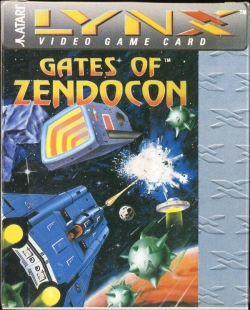
Gates of Zendocon is a horizontally scrolling shooter developed by Epyx and published by Atari Corporation in 1989 in North America and Europe for the Atari Lynx. It was released in Japan on December 23 of the same year, where it was distributed by Mumin Corporation. One of the first games written for the platform, it was one of the launch titles that were released along with the system in North America.
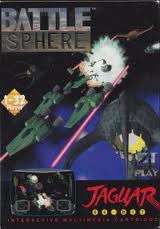
BattleSphere is a space combat simulation video game developed by 4Play for the Atari Jaguar. The game was released in 2000, with the enhanced edition BattleSphere Gold released in 2002. Set during a future war between seven alien races, the factions agree to confine their hostilities to a tournament with the galaxy at stake. Gameplay consists of five modes, each featuring distinct scenarios and objectives. Up to 16 players can participate in a deathmatch mode via local area network (LAN) play.

Halo 2600 is a 2010 action-adventure game developed by Ed Fries and published by AtariAge for the Atari 2600, a video game console released in 1977 that ended production in 1992. Inspired by the Halo video game series, the game sees players control Master Chief and fight through 64 screens with varied enemies. Completing the game once unlocks a tougher "Legendary" mode.

The first hobbyist-developed game for the Atari 2600 video game console was written in 1995, and more than 100 have been released since then. The majority of games are unlicensed clones of games for other platforms, and there are some also original games and ROM hacks. With only 128 bytes of RAM, no frame buffer, and the code and visuals closely intertwined, the 2600 is a difficult machine to program. and many games were written for the technical challenge. Emulators, programming tools, and documentation are available.

Fast Striker is a video game developed and published by German developer NG:Dev.Team in 2010 for the Neo Geo MVS. The player flies a space fighter craft through vertically scrolling levels to shoot waves of enemies. The game was later ported to Dreamcast, iOS, Neo Geo AES, PlayStation 4 and PlayStation Vita.

Nightmare Busters is a 2013 run and gun action video game developed by Arcade Zone and Super Fighter Team for the Super Nintendo Entertainment System. It is the first new game for the console in North America since Frogger (1998), fourteen years after being discontinued in North America. A mobile phone version called Flynn's Adventure was released in 2004. A revival titled Nightmare Busters: Rebirth was announced in 2021 for consoles and PC. The game follows the leprechaun twin brothers Flynn and Floyd on their journey to stop Tyrant from infiltrating and turning children's dreams into nightmares. The player is tasked with fighting off enemies by using playing cards and magic attacks across six stages, populated with an assortment of obstacles.
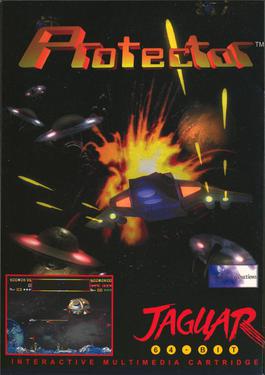
Protector is a scrolling shooter video game developed by Bethesda Softworks for the Atari Jaguar. The game was released in 1999, with the enhanced edition Protector: Special Edition released in 2002 and the Atari Jaguar CD expansion pack Protector: Resurgence released in 2014. Set in a future where an interstellar war broke out when alien forces arrived on Earth, the player controls the Starblade ship to defeat waves of invading aliens while protecting the inhabitants of Haven-7.

Mad Bodies is a homebrew Breakout-style/shoot 'em up video game developed and published by FORCE Design exclusively for the Atari Jaguar on May 2, 2009. It is the first and only title to be released for the platform as of date by FORCE Design.

Championship Rally is a homebrew racing video game developed and published by Songbird Productions exclusively for the Atari Lynx on December 15, 2000. Themed around rallying, the players compete with either AI-controlled opponents or against other players in matches across various locations.

Batman Returns is a 1992 side-scrolling action-beat 'em up video game developed and published by Atari Corporation in North America and Europe for the Atari Lynx. Based on the DC Comics superhero Batman, it is inspired by the Warner Bros.'s 1992 film of the same name. In the main storyline, Batman must confront both Catwoman and the Penguin.

The Evercade is a handheld game console developed and manufactured by UK company Blaze Entertainment. It focuses on retrogaming with ROM cartridges that each contain a number of emulated games. Development began in 2018, and the console was released in May 2020, after a few delays. Upon its launch, the console offered 10 game cartridges with a combined total of 122 games.
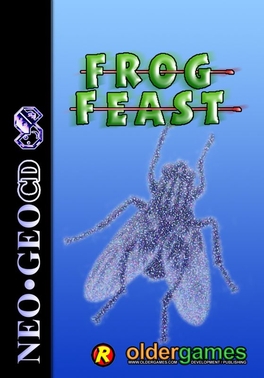
Frog Feast is a 2005 action homebrew video game developed by Rastersoft and originally published by OlderGames for the Neo Geo CD and Sega CD. It was later ported to Sega Genesis, Super Nintendo Entertainment System, X68000, CD-i, Atari Jaguar CD, Atari Jaguar, Amiga CD32, Dreamcast, and FM Towns Marty. Gameplay is similar to Frog Bog (1982), revolving around players controlling frogs on lilypads attempting to eat more flies than the other as the objective under a set time limit.


